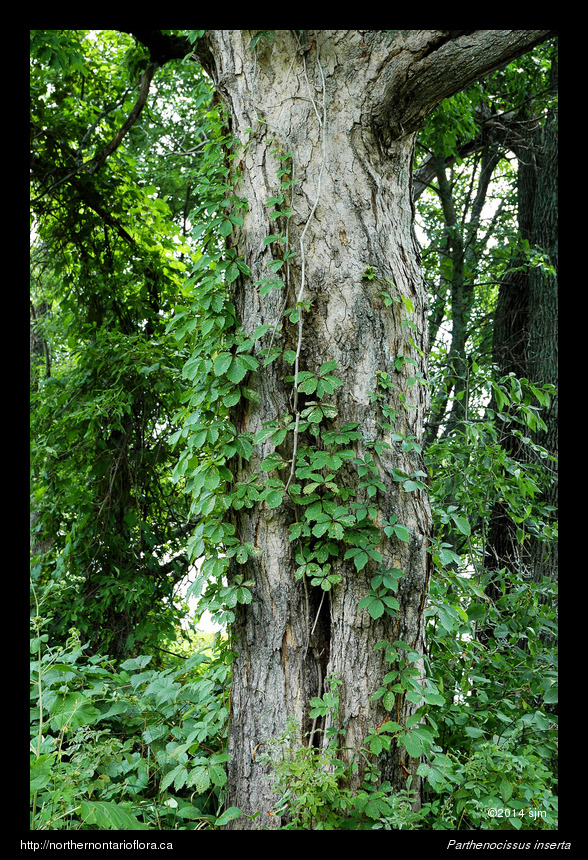
|
Northern Ontario Plant Database 
Plant DescriptionParthenocissus inserta (A.Kern.) FritschEn: thicket creeper, grape woodbine, false Virginia creeper
Vitaceae (Grape Family) General: A deciduous woody vine with climbing stems that can exceed 10 m in length; vines can grow 1—3 m per year. To prevent the possibility of tripping accidents caused by entangled climbing stems, thicket creeper should be removed from areas around towers and utility poles. Taxonomy: J.S. Pringle's 2010 paper describes how Parthenocissus inserta differs from Virginia creeper, Parthenocissus quinquefolia (L.) Planch. and explains why P. inserta is the accepted name, rather than P. vitacea (Kneer) Hitchc. See J.S. Pringle. 2010. Nomenclature of the thicket creeper, Parthenocissus inserta (Vitaceae). Michigan Botanist 49(3): 73-78. Stems/twigs: Young branches are green and finely hairy; winter twigs are greenish-brown, smooth (glabrous), with scattered warty lenticels, and solid white pith; buds are alternate, broadly conical, scaly, and partially submerged in the stem; leaf scars are round, concave in the centre, with several bundle scar. Tendrils arise from the stem opposite (behind) the leaves or leaf scars. Tendrils are 3—5 branched and typically coil around vertical shoots for support; however, when tendril tips become inserted into dark narrow cracks (crevices in bark or splits in wooden utility poles), they expand to produce a thickened callus that tightly wedges the tendril in place, allowing the plant to climb higher. Leaves: Alternate, palmately compound, 3—20 cm wide, with 5 short-stalked leaflets; the long petioles are 15—20 cm long and often reddish. Young leaves are sparsely hairy; mature leaves are dark green, glabrous, and glossy above; green and glabrous beneath. Leaflet blades are elliptic, oblanceolate, or obovate, 5—20 cm long by up to 10 cm wide, with pinnate venation. Leaflet bases are tapering to nearly rounded, the apex may be acute or taper to a sharply pointed (attenuate) tip, and margins are coarsely serrate, at least above the middle. Flowers: Flowers are small, to 5 mm across, green to greenish-purple, with 5 stamens and a superior ovary. Inflorescences (compound cymes) contain 10—60 flowers, lack a central rachis, and branch dichotomously (dividing into equal branches) throughout the inflorescence. Fruit: Open branched clusters of globose dark blue berries, 8—10 mm across with 3—4 seeds; fruiting pedicels are bright red and glabrous. Fruiting branches grow close to the ground, so are easily visible. The berries mature in September to October. Habitat and Range: Sunny or partially shaded sites along roadsides, thickets, clearings, open rocky forests and forest edges, rock outcrops, and streambanks. Thicket creeper occurs in the southern half of the Algoma District, extending N to about 47°N, as well as southern and eastern Ontario, and in southern portions of northwestern Ontario. In Canada, its range extends from Quebec to Manitoba. Similar Species: Thicket creeper is very similar to the Virginia creeper (Parthenocissus quinquefolia), which has climbing tendrils that attach themselves by rounded discs to the surface of a structure; the tendril tips expand on contact to a supporting surface. Virginia creeper has an inflorescence with 25—200 flowers and a zigzag central axis with dichotomous branching only in lateral flower clusters. Fruits are produced high up in the plant, so are seldom seen at ground level; the berries are smaller than those of thicket creeper, 5—7 mm in diameter, with 1—3 seeds. Back to species list |
||||||||||||||||||||||






















